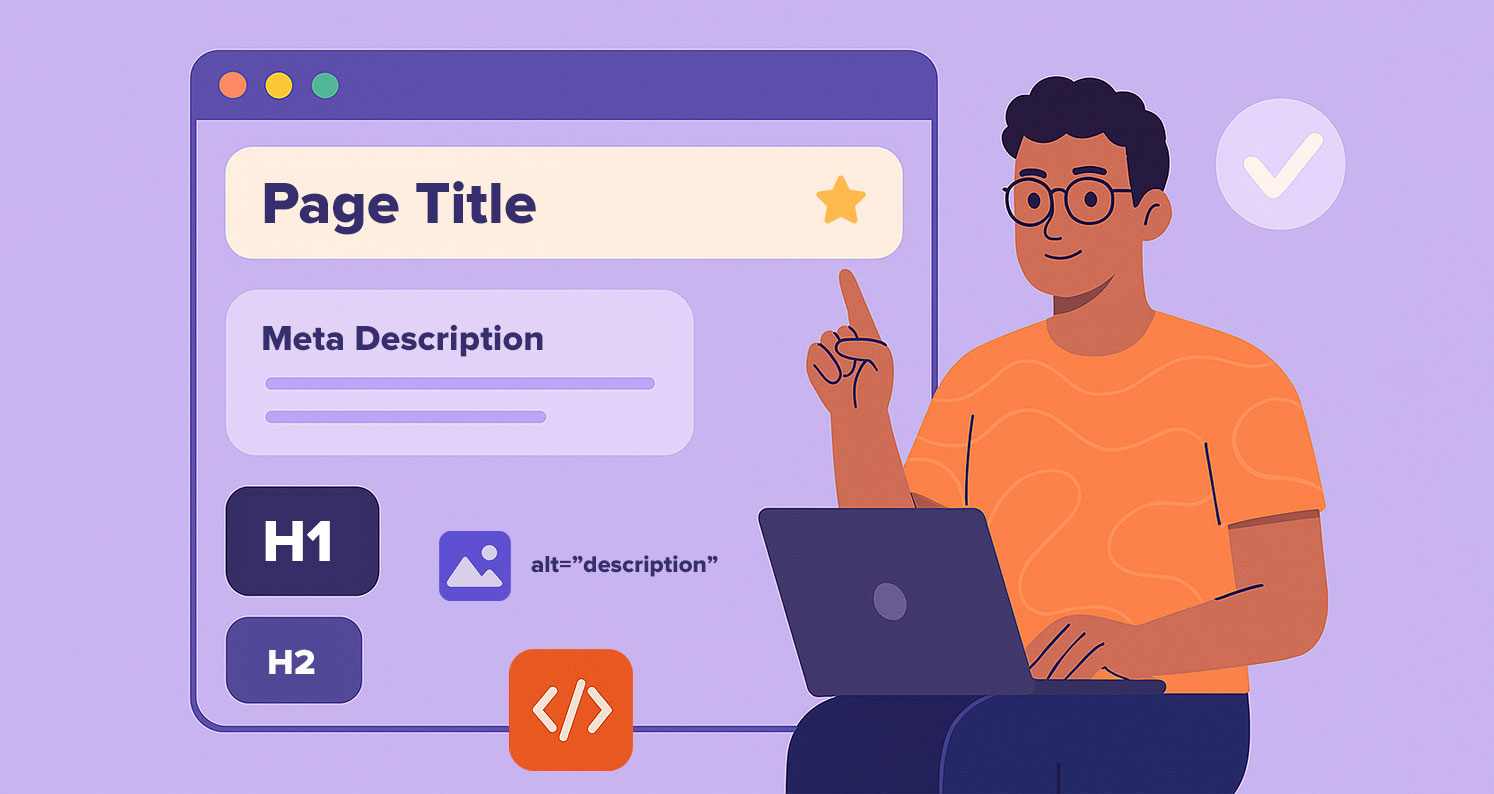Small Business SEO: What to Prioritize?
Struggling with SEO for your small business? Here’s how to prioritize for better rankings, more traffic, and long-term growth.

When it comes to SEO, trying to do everything at once can leave you overwhelmed by the work and underwhelmed by the results.
Instead of doing it all at once, it’s better to start with the opportunities that can net the best outcomes.
But how do you know what to prioritize?
In this guide, we cover the SEO strategies small businesses should tackle first, highlighting key tactics for lasting visibility.
What is SEO for small businesses?
SEO is short for “Search Engine Optimization.” Small business SEO can bolster your website’s visibility in Google, Bing, and other search engines. This visibility translates directly into more traffic, increased brand awareness, and higher revenue.
Why is SEO important for small businesses?
For small businesses, SEO is crucial. SEO marketing strategies can help you compete with larger companies or local competitors on a limited budget.
This is because, unlike performance marketing channels, there’s no additional ad spend. Long-term results are achievable without the need to pay for placements.
When done right, SEO helps potential customers find you when they need your products or services. You can focus on local visibility, if that’s what you want, but you can also grow national or global presence by taking the right steps.
What’s the difference between SEO and SEM?
SEM is short for “Search Engine Marketing.” It typically refers to paid ad campaigns through search engine results.
These pay-per-click (PPC) ads provide instant visibility. However, performance vanishes the moment you stop spending. Think of PPC as renting real estate in a prime location. If you stop paying, you lose the space quickly.
On the other hand, SEO works through properties you already own. Once you have these properties, you can use them to grow your presence, providing ongoing returns without bidding or ad fees.
Both SEO and SEM have value. When synergized, they enable brands to command more presence in search results, meaning even greater visibility and traffic.
Learn more about paid media services.
How does SEO give smaller businesses a competitive advantage?
Large brands often dominate broad, general search terms. However, small businesses have a unique advantage: Niche targeting.
This means you have an edge when targeting specific keywords closely aligned with your unique products or services. These focused, long-tail keywords attract customers who already know what they’re looking for.
Blend a targeted keyword strategy with local SEO to significantly boost your visibility:
- Optimize your Google Business Profile.
- Build local citations and mentions of your business across local directories.
- Encourage and engage authentic customer reviews.
Together, these actions can position your small business prominently in local search results. This helps you attract nearby customers who are ready to buy.
What else should small business owners know about SEO?
Ranking at the top of search results is about more than traffic. It’s also about trust.
Consistent visibility builds credibility, positioning your brand as an authoritative, trustworthy option in the minds of customers.
Good SEO practices build brand authority and credibility, too. Over time, this trust converts visitors into loyal customers, fueling sustainable business growth.

Optimize key SEO elements like titles, meta descriptions, headings, and alt text to improve website visibility and organic rankings.
What SEO strategies should small businesses prioritize?
As a small business owner, you can’t do everything at once. That’s why it’s important to start with SEO basics. These actions can drive quick, meaningful results.
Whether you want to do it yourself or hire an agency, these key strategies often give the best results for your time and effort.
Targeted Keyword Research
Keyword research is your starting point. Understanding what your customers search for (and why) can help you drastically improve your visibility.
Identify the main areas of your business. Think about the products or services you offer, and the common questions customers ask you.
We do this because we’re looking to analyze search intent. You must think about what your customers are trying to accomplish when they search for terms related to your brand.
- Informational: They want to learn or find answers (e.g., “how to bake bread”).
- Navigational: They’re looking for a specific site or web page (e.g., “Facebook login”).
- Transactional: They’re ready to buy or take action (e.g., “buy running shoes”).
To attract the right visitors, it’s key that you match your content to your audience’s intent. Many business owners find this challenging. Many people often focus on terms with higher search volume, sacrificing relevancy. This is where an agency can help you focus your efforts.
Plenty of tools are available to support your keyword research. You can turn to Google Keyword Planner or a third-party paid tool to get information on search volume. However, keyword research is a bit of an art. An SEO expert can help you avoid common pitfalls and identify the most appropriate terms for your business to pursue.
Metadata Optimization
Good SEO practices send clear signals to search engines and users about the intent of your pages.
Start with your title tags (i.e., <title>). These are the titles that appear in Google Search listings.
Title tags should be concise, keyword-focused, and accurately reflect the content on the page. A strong title helps search engines rank your page appropriately and encourages users to click. You can typically find a field to edit your title tag when editing the page on your site.
Follow that with compelling meta descriptions. This is a 150–160-character tag that provides more context about your content and can entice users to come to your site. While these aren’t a ranking signal, they can affect the likelihood that someon will click your listing over another organic search result.
Similar to page titles, there should be a field to enter a meta description when editing each individual page on your website.
Use clear HTML headings (H1, H2, H3) to organize your content in a logical flow. This structure helps readers navigate your page easily and allows search engines to understand the hierarchy of your information. HTML headings appear directly within the body content of your website.
Remember: Use HTML section headings to structure content. Don’t use another heading just because it looks pretty. That’s what CSS is for!
Done well, optimized title tags, descriptions, and headings can significantly improve your visibility and drive more engagement from search.
Improving Site Performance
Even if you create high-quality content, your site won’t rank as well if it loads slowly. A site that’s not mobile-friendly or has broken links and errors is a sure way to lose trust among visitors.
Poor website performance hurts your ranking potential. Frustrated visitors won’t stick around. This can raise your bounce rate, signaling to Google that your site is not user-friendly.
Imagine searching for a nearby bakery and clicking a promising link. How long would you wait if that site didn’t load? Chances are, you’ll hit the back button within seconds and seek out a different bakery.
Search engines recognize this frustration and prioritize websites that offer fast, mobile-friendly experiences.
To avoid losing potential customers, regularly audit your website using tools like Google PageSpeed Insights (PSI) or Google Search Console (GSC).
PSI and GSC can help you optimize slow-loading pages, broken links (404 errors), poor mobile experience, and more. Addressing these opportunities can help you keep your visitors—and search engines—happy.

Collaborating with an agency on SEO strategies can drive growth, visibility, and long-term success.
Content Publishing & Optimization
Consistent, high-quality content is one of the most effective ways to drive organic traffic. It positions your business as a trusted resource and helps search engines understand the value you offer.
Focus on creating engaging, informative, and original content that directly answers your customers’ questions and meets their needs. Use clear formatting like headings, short paragraphs, bullet points, images, and internal links to improve both readability and SEO.
When it comes to content, quality and helpfulness are key. Publishing fewer well-optimized, useful posts is typically more effective than pushing out junk to keep a schedule.
And remember, you’re writing for people first, not search engines. High-quality content that genuinely helps your audience keeps them on your site longer, builds trust, and ultimately leads to more conversions.
Google Business Profile & Local Listings Optimization
Optimizing Google Business Profile(s) is one of the most effective ways for small businesses to boost local visibility.
A complete, accurate, and regularly updated profile helps your business appear prominently in Google Maps and the local “3-pack.” This positions you directly in front of nearby customers.
For instance, imagine someone searches “plumber near me.” Google immediately displays a “map pack,” highlighting several relevant businesses close to the searcher’s location.
Keeping your profile detailed and updated greatly increases your visibility in local searches. This helps attract customers who are ready to visit or buy.
Since a more complete Google Business Profile is more likely to be seen, be sure to include these essential details:
- Business name, address, and phone number (NAP).
- Detailed operating hours (including holidays).
- Link to your website and online appointment scheduling.
- High-quality photos of your storefront, products, or services.
- Business categories and descriptions that clearly outline what you offer.
It’s also important to actively manage your business details across local directories like Yelp or Yellow Pages. Naturally, you’ll also want to ensure your info appears correctly on industry-specific platforms.
Consistent, accurate information across these sites signals reliability, building trust with both Google and potential customers.
Lastly, always respond promptly to customer reviews, both positive and negative. Reviews directly impact local search rankings and influence customer decision-making.
By thoughtfully engaging with reviewers, you demonstrate genuine care for customer satisfaction, enhancing your local reputation and credibility.
SEO is a powerful marketing practice for any small business.
While we’ve only scratched the surface, we hope this article helps you get started. There are plenty other advanced SEO tactics for small businesses, such as link building, structured data, and more.
SEO is one of the wisest investments your small business can make. Approached correctly, it can drive sustainable growth, boost your visibility online, and set you up for lasting success.
Don’t have the time to tackle SEO yourself? Have Gen3 Marketing handle the heavy lifting. Contact us for a free SEO audit and accelerate your business growth today.
More Blogs
Ecommerce Search Optimization Checklist
Get your online store SEO, GEO, and AEO ready with this helpful checklist from a digital search expert.The ecommerce landscape is changing fast. Search engines now blend traditional ranking signals with AI-generated answers, localized results, and real-time product...
Psychological Safety: How it Drives Better Marketing Solutions
Fostering an environment where team members feel psychologically and emotionally safe leads to better marketing outcomes.As agency work environments grow more flexible, workplace culture must evolve as well. For agencies, like Gen3 Marketing, who strive to deliver...
How AI & Voice Commerce Are Changing Affiliate Marketing
Artificial Intelligence (AI) and voice commerce are changing the affiliate marketing channel. Learn how you can capitalize on the new opportunities offered by these technologies.Artificial intelligence and voice commerce are transforming how consumers discover and...

 By
By 

